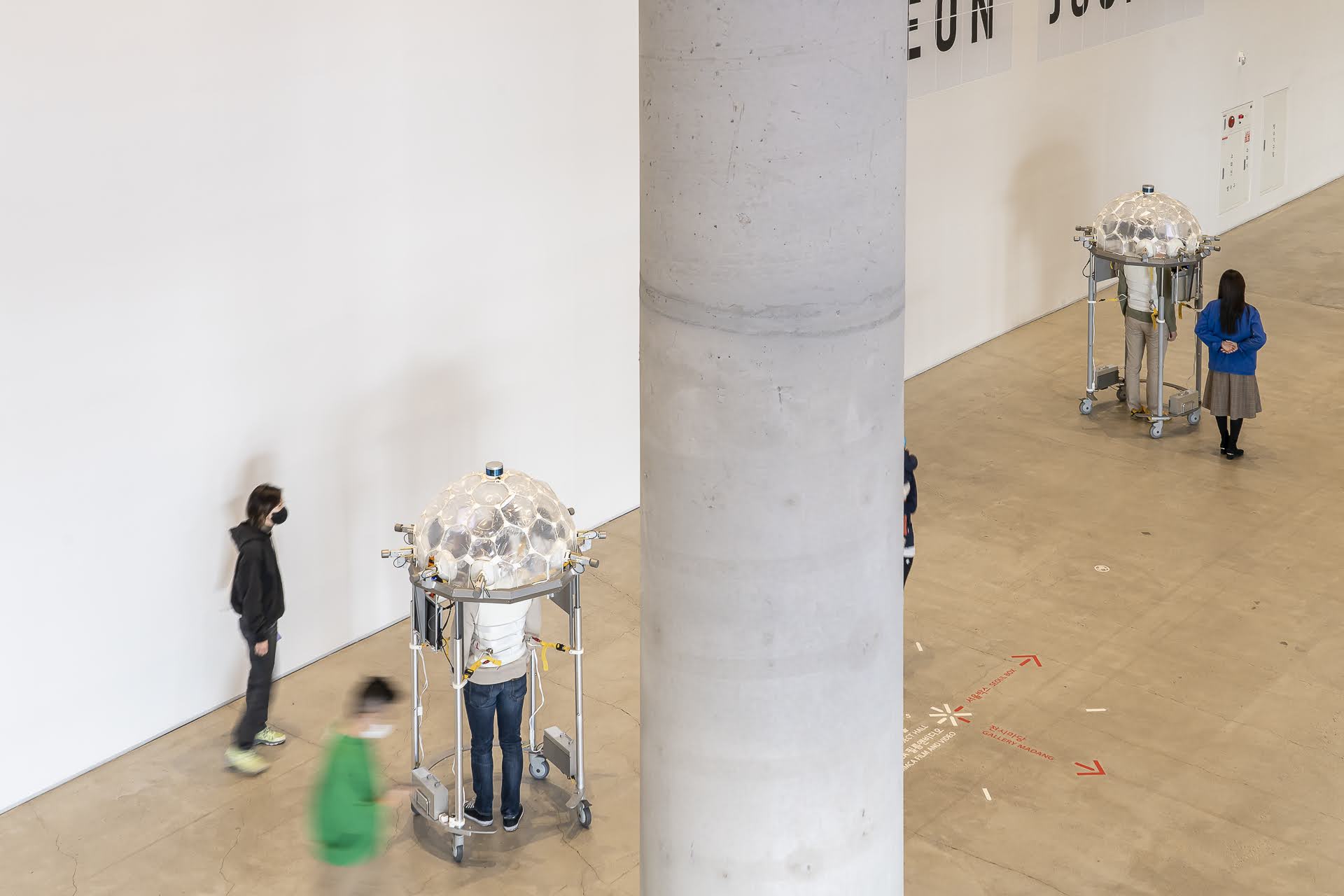Landscape being decoded 2021
MMCA Performing Arts 2021: Multiverse
<MMCA Performing Arts 2021: Multiverse> Landscape being decoded , National Museum of Contemporary Art, Seoul, korea 2021
2 datascapes, video, sound, booklets, 4 navigators, installation, mixed media, dimensions variable.
Landscape being Decoded is an attempt to sense and recognize the environment and space around us differently from the way we currently do it through “Datascape,” an “environmental recognition apparatus.” Unlike the human eye, the eyes of a self-driving car, LiDAR (Light Detection And Ranging) sensors perceive space in a 360- degree field. This sensor emits laser pulses, measures the time it takes for the pulses to return, and thereby analyzes the spatial location of the reflected point.
This work temporarily implants Datascape in a human body, making it possible for viewers to perceive “something” that exists but is difficult to sense. Datascape collects spatial information and translates them to auditory information; hearing is the fastest to recognize the surrounding situation, a sense that has the least latency, a 24-7 surveillance system, and a sense that can be used to identify the space in 360-degrees.* The auditory sense is primeval, and paradoxically it is the most mechanical sense of all.
Each medium, including human eyes and ears, cameras, and LIDAR sensors, have their own way of reading the space around them. Thanks to the emergence of various media and technology, we can now select the method of recognizing the environment and the space that surrounds us. This has helped in expanding our perceptive system. Also, by suggesting a different way of thinking (the algorithm), Datascape suggests that the “topology” of the environment and the space can change. Under the keyword of “multiverse,” this work raises an interesting question on the “world.” If the world is the result of subjectivity and recognition, to whom does a world belong, when it is sensed and perceived through a different, borrowed system?
* Hearing is an objectively faster processing system. While vision maxes out at fifteen to twenty-five events per second, hearing is based on events that occur thousands of times per second. While with vision it takes several hundred-millisecond, it takes only about 50 milliseconds or less for you to identify a sound and point to where it’s coming from.
— From Seth Horowitz, The Universal Sense, New York: Bloomsbury, 2013.
‹디코딩 되는 랜드스케이프›는 관객이 직접 장착할 수 있는 ‘환경 인지 장치’인 ‘데이터스케이프(Data- scape)’를 통해 환경과 공간을 기존의 방식과는 다르게 감각, 인식하려는 시도이다. 인간의 눈과 달리, 자율주행차의 눈이라고 할 수 있는 라이다(LiDAR, Light Detection And Ranging) 센서는 360도로 공간을 인식한다. 이 센서는 레이저 펄스를 발사해서 돌아오는 시간을 측정해 반사지점의 공간위치를 분석한다.
이 작업은 ‘데이터스케이프’를 인간의 신체에 일시적으로 이식(implant)하여, 존재하지만 쉽게 감각할 수 없는 ‘어떤 것’을 지각하게 해준다. ‘데이터스케이프’는 공간 정보를 수집해 이를 주변 상황을 인식하는 데 가장 빠르고 딜레이가 적은 감각 이자, 24시간 작동하는 경보시스템이며, 360도로 공간을 파악할 수 있는 청각 정보로 번역한다.* 청각은 이렇듯 원시적인 감각이자 역설적으로 가장 기계적인 감각이다.
인간의 눈과 귀, 카메라, 라이다 센서 등 여러 매체는 각자 자신만의 방식으로 공간을 읽어낸다. 다양한 매체와 기술 덕분에 우리는 환경과 공간을 인식하는 방법을 선택할 수 있게 되었고, 이는 우리의 지각 체계를 확장할 수 있게 해주었다. 더불어 또 다른 사고방식(알고리즘)을 제시하는 ‘데이터스케이프’는 환경과 공간의 ‘위상’이 변화될 수 있다는 것을 제안한다. 멀티버스라는 키워드 안에서 이 작업은 ‘세계’에 대해 흥미로운 질문을 던진다. 세계가 주관과 인식의 결과물이라면 다른 감각기관과 인식 체계를 빌려온 세계는 누구의 것인지를 말이다.



“Datascape-Type01_E0~1”

청각은 객관적으로 더욱 빠른 처리 시스템이다. 시각은 초당 15~25번이 최대치지만, 청각은 초당 수천 번 일어나는 사건에 바탕을 두고 있다. 시각 신호를 최종적으로 판단하고 출처를 알아내는 데 걸리는 시간은 수백 밀리초이지만, 청각은 50밀리초도 채 걸리지 않는다.
— 세스 S. 호로비츠, 『소리의 과학: 청각은 어떻게 마음을 만드는가?』, 노태복 역, 파주: 에이도스, 2017, 5장


commissioned by
MMCA National Museum of Modern and Contemporary Art, Seoul
related links
Public art_February issus(interview)
©HOONIDAKIM